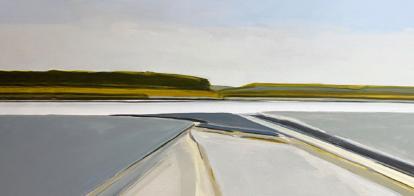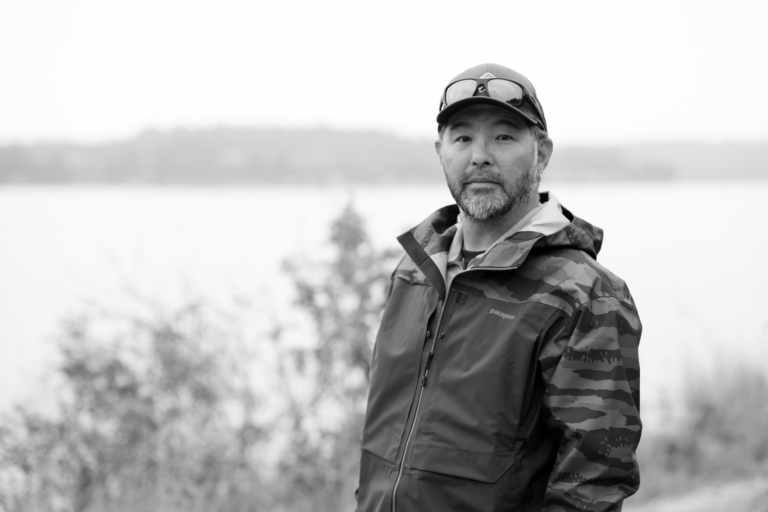Running Out of North
An excerpt from Dylan Tomine’s Headwaters: The Adventures, Obsession, and Evolution of a Fly Fisherman proves he was born to fish and born to write.
Editor’s note: As novelist John Larison notes in the forward to Dylan Tomine’s new book, Headwaters: The Adventures, Obsession, and Evolution of a Fly Fisherman, “Part of Tomine’s charm on the page … is that he sounds like the ideal campfire guest. He’s funny and profound, humble, and well traveled.” There’s also another side to Tomine, and it’s the wild fish activist committed to protecting wild places, wild waters and wild fish. The line that connects these two is, of course, love. Throughout Headwaters, we encounter a soulful writer both enchanted, and enchanting, and profoundly committed to protecting what he loves.
The following is an excerpt from Headwaters: The Adventures, Obsession, and Evolution of a Fly Fisherman published by Patagonia in 2022.
This is the spot I’ve been waiting for all day—a secret midriver bucket that holds fish even when there’s a parade of anglers pounding the water ahead of you. I pull back hard on the oars and drop anchor, letting two or three boat-lengths of line trail out before chocking it off. The anchor bounces downstream until finally, it grabs, and we lurch to a halt.
On river left, three-quarters of the flow runs across a broad tailout. On the right, jade-green water moves at walking speed through a narrow trough. Under the boat lies a submerged island of loose cobble—knee-deep here but gradually falling away under ever deeper, faster current. Fish far enough downstream and you’ll never make it back to the boat. I scramble over the gunwale, hands shaking with anticipation.
I used to come to this river to escape the conservation battles surrounding our dwindling steelhead returns in Puget Sound. For Pacific Northwest anglers, northward travel works like a time machine—the farther you go, the more years recede. When I first started fishing this great Skeena tributary, it was everything I imagined Puget Sound rivers must have been a hundred years ago. No hatcheries. No clear-cuts. No toxic runoff from suburban sprawl. Just perfect water and wild, free-rising steelhead. I had found the good old days.
My first cast settles on the water and I make a big upstream mend, followed by a shorter downstream mend to make up for slower water eddying along the submerged island. As it starts to swing, my heart pounds. When the line trails below me, I pick up, cast, mend, and take two steps downstream.
Memories float through my mind: the day we found this spot and discovered we had to turn our backs on the classic tailout and fish toward the bank; the huge chrome hen that rocketed downstream, forcing Nate to ferry me to shore in the boat; Tim blasting elegant single Speys into the wind amid a cadmium blizzard of cottonwood leaves.
This river, though, is changing. The fish politics and destructive forces I came here to escape are creeping in. Or maybe it’s just my awareness of them. This is a region rich with natural resources—precious metals, fossil fuels, timber, salmon—and a convenient path to the Pacific from the tar-sand oil fields of Alberta. As long as opportunities for profit exist, threats will hover over the river. Constant vigilance must be maintained. And now, despite the vast amount of money brought into local economies by visiting anglers, the government has closed the river to us foreigners for two days every week. We do not feel very welcome here anymore.
Back in the present, the familiar rhythm of steelhead fishing takes hold and troubling thoughts fade. I work my way down the deepening gravel bar absorbed by the water in front of me. Cast, mend, two steps down. With each swing, the water fishes better.
I don’t know when I will be back. Tim sold his house in Telkwa, Nate didn’t come this year, and life at home, with two kids in school and a farm to work, has become more complicated. Time is moving on.
Two more steps and the current starts washing gravel out from beneath my feet. Water pushes against my waist, running fast enough to raise a bow wake on my upstream side. But still, it’s fishing better with each cast. The line swings through on another perfect arc and comes tight with a soft grab, then nothing. I cast again, but come up empty. I can’t stop now. Two more steps and I feel buoyancy taking over and the shocking bite of forty-three-degree water seeping in over the top of my waders. I make the mend with arms above my head. When it starts to swing, I hold my breath.
Where will I fish next season? Am I giving up on this river? There are still major watersheds up the coast worth exploring, and hundreds of smaller rivers, too. But where will we go after that? We are running out of North.
My line comes tight again, solid this time. The fish explodes, streaking downstream, and I understand there is no choice: I have to stand my ground and fight.

